ICSE Biology Previous Year Question Paper 2012 Solved for Class 10
ICSE Paper 2012 BIOLOGY
SECTION-I (40 Marks)
(Attempt all questions from this Section)
Question 1:
(a) Name the following :
(i) The phenomenon by which living or dead plant cells absorb water by surface attraction.
(ii) The phase of cardiac cycle in which the auricles contract.
(iii) The organ where urea is produced.
(iv) The hormone that helps increase the reabsorption of water from the kidney tubules.
(v) Chemical substances produced by micro organisms that can kill or inhibit
the growth of other micro organisms. [5]
(b) Choose the correct answer from the four options given below each statement:
(i) BCG vaccine is used to build immunity against :
(A) Poliomyelitis (B) Tuberculosis (C) Malaria (D) Whooping cough
(ii) A plant is kept in a dark cupboard for about 48 hours before conducting any experiment on photosynthesis to :
(A) Remove starch from the plant
(B) Ensure that starch is not translocated from the leaves
(C) Remove chlorophyll from the leaf of the plant
(D) Remove starch from the experimental leaf
(iii) The part of the human eye where rod cells and cone cells are located is the :
(A) Retina (B) Cornea (C) Choroid (D) Sclera
(iv) A reflex arc in man is best described as movement of stimuli from :
(A) Receptor cell, sensory neuron, relaying neuron, effector muscles.
(B) Receptor cell, efferent nerve, relaying neuron, muscles of the body
(C) Receptor cell, spinal cord, motor neuron, relaying neuron.
(D) Receptor cell, synapse, motor neuron, relaying neuron.
(v) NADP is expanded as :
(A) Nicotinamide, adenosine dinucleostide phosphate
(B) Nicotinamide, adenine dinucleotide phosphate
(C) Nicotinamide, adenine dinucleous phosphate
(D) Nicotinamide, adenosine dinucleous phosphate [5]
(c) State the main function of the following :
(i) Chordae tendinae
(ii) Lymphocytes
(iii) Seminiferous tubule
(iv) Thylakoids
(v) Beta cells of pancreas [5]
(d) Give the exact location of the :
(i) Lenticels (ii) Prostate gland (iii) Thyroid gland (iv) Centrosome (v) Mitral valve [5]
(e) Given below are sets office terms each. In each case rewrite the terms in logical sequence as directed at the end of each statement. An example has been done for you :
Example :
Cortical cells, Root hair, xylem, Soil water, endodermis (absorption of water by the plants)
Answer : Soil water, Root hair, cortical cells, endodermis, xylem.
(i) Active immunity, Antigen, Antibody, Bacteria, Lymphocytes (defence mechanism of the body).
(ii) Implantation, Parturition, Ovulation, Gestation, Fertilisation (stages leading to formation of foetus and birth).
(iii) Oval window, Tympanum, Cochlea, Auditory canal, Ear ossicles (path through which a vibration of sound is transferred in the human ear).
(iv) Karyokinesis, S-phase, Cytokinesis, G1 phase, G2-phase (cell cycle).
(v) Renal vein, Renal artery, Afferent arteriole, Efferent arteriole, Glomerulus
(pathway of blood through glomerulus). [5]
(f) Study the following diagram carefully and then answer the questions that follow. The diagram is depicting a defect of the human eye :
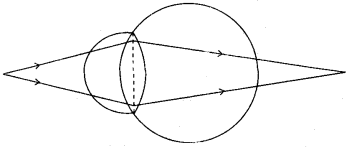 (i) Identify the defect shown in the diagram.
(i) Identify the defect shown in the diagram.
(ii) Give two possible reasons for the above defect.
(iii) Draw a neat labelled diagram to show how the above defect can be rectified. [5]
(g) Match the items in Column A with that which is most appropriate in Column B. Rewrite the matching pairs : [5]
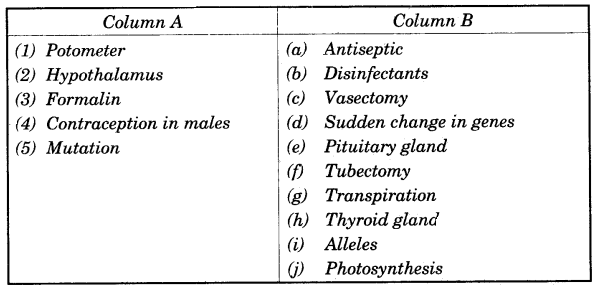 (h) Given below are six sets with four terms each. In each set a term is an odd one and cannot be grouped in the same category to which the other three belong. Identify the odd one in each set and name the category to which the remaining three belong. The first has been done for you as an example. [5]
(h) Given below are six sets with four terms each. In each set a term is an odd one and cannot be grouped in the same category to which the other three belong. Identify the odd one in each set and name the category to which the remaining three belong. The first has been done for you as an example. [5]
 Answer:
Answer:
(a) (i) Imbibition
(ii) Auricular systole
(iii) Liver
(iv) Antidiuretic hormone/Vasopressin
(v) Antibiotics
(b) (i) (B) – Tuberculosis
(ii) (D) – Remove starch from the experimental leaf
(iii) (A) – Retina
(iv) (A) – Receptor cell, sensory neuron, relaying neuron, effector muscles
(v) (B) – Nicotinamide, adenine dinucleotide phosphate
(c) (i) Chordae tendinae – Holds the valves in position.
(ii) Lymphocytes – Produce antibodies to defend the body against infection.
(iii) Seminiferous tubule – Produce sperms
(iv) Thylakoids – Chlorophyll is located on the wall of thylakoids so light reaction of photosynthesis begins here.
(v) Beta cells of pancreas – Secrete insulin that helps to lower the level of glucose in blood.
(d) (i) Lenticels – On the older stens
(ii) Prostate gland – Between the urinary bladder and the point where sperm ducts join the urethra.
(iii) Thyroid gland – In the front part in the neck
(iv) Centrosome – Above the nucleus in animal cells.
(v) Mitral value – Between the left auricle and left ventricle.
(e) (i) Active immunity, Bacteria, Antigen, Lymphocytes, Antibody.
(ii) Ovulation, Fertilisation, Implantation, Gestation, Parturition.
(iii) Auditory canal, Tympanum, Ear ossicles, Oval window, Cochlea.
(iv) G1-phase, S-phase, G2-phase, Karyokinesis, Cytokinesis.
(v) Renal artery, Afferent arteriole, Glomerulus, Efferent arteriole, Renal vein.
(f) (i) Hypermetropia
(ii) (a) The eye ball is too short from front to back.
(b) The lens is too flat.
(iii)
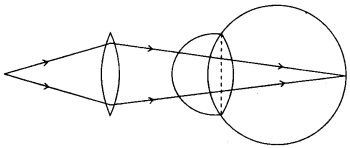
(g)

(h)
w
SECTION-II (40 Marks)
(Attempt any Four questions from this Section)
Question 2:
(a) Given below is an experimental set up to demonstrate a particular process. Study the same and answer the questions that follow :
 (i) Name the physiological process being studied.
(i) Name the physiological process being studied.
(ii) Explain the process mentioned above.
(iii) What is the aim of the above experiment ?
(iv) What would you observe in the experimental set-up after an hour ? Give a reason to support your answer.
(v) Mention any three adaptations found in plants to overcome the physiological process mentioned in (i) above. [5]
(b) Give the biological / technical terms for the following :
(i) A membrane which allows the passage of molecules selectively.
(ii) The suppressed allele of a gene.
(iii) Structure that carries visual stimuli from retina to the brain.
(iv) WBCs squeeze through the walls of the capillaries into the tissue.
(v) Protective coverings located round the human brain and spinal cord.
(vi) Eye lens losing flexibility resulting in a kind of long sightedness in elderly people.
(vii) Hormones which stimulate other endocrine glands to produce their specific hormones.
(viii) The phase in the menstrual cycle in which the remnant of follicle in the ovary turns to Corpus luteum.
(ix) Statistical study of human population.
(x) Artificially introducing weakened germs or germ substance into the body for developing resistance to a particular disease. [5]
Answer:
(a) (i) Transpiration.
(ii) Two cobalt chloride papers are attatched, one on the dorsal and the other on the ventral surface of a dorsiventral leaf with the help of glass slide and clips. The set up is left in the open for few hours.
(iii) To show that more transpiration occurs from the ventral surface of a dicot leaf.
(iv) After an hour, the cobalt chloride paper placed on the ventral surface turns blue to pink faster than the one on the upper surface.
Because no. of stomata are more on the ventral surface, so more transpiration takes place from the lower surface.
(v) 1. Cuticle becomes thick.
2. Leaves becomes narrow.
3. Stomata covered by hair like structures.
(b) (i) Selectively permeable membrane
(ii) Recessive character
(iii) Optic nerve
(iv) Diapedesis
(v) Meninges
(vi) Presbypopia
(vii) Tropic Hormones
(viii) Luteal phase
(ix) Demography
(x) Vaccination
Question 3:
(a) Given below is the diagram of a cell as seen under the microscope after having been placed in a solution:
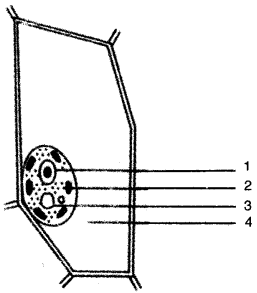 (i) What is the technical term used for the state icondition of the cell given above ?
(i) What is the technical term used for the state icondition of the cell given above ?
(ii) Give the technical term for the solution in which the ceil was placed.
(iii) Name, the parts numbered 1 to 4.
(iv) Is the cell given above a. plant cell or an animal cell ? Give two reasons in support of your answer as evident from the diagram.
(v) What would you do to bring this cell back to it original condition ? [5]
(b) Differentiate between the following pairs on the basis of what is mentioned in brackets:
(i) Natality and Mortality (definition)
(ii) Stoma and Stroma (describe its structure.)
(iii) Acromegaly and Cretinism (symptoms)
(iv) Transpiration and Guttation (structures involved)
(v) Diabetes mellitus and Diabetes insipidus (reason) cause). [5]
Answer:
(a) (i) Plasmolysed
(ii) Hypertonic solution
(iii) (1) Nucleus (2) Chloroplast (3) Vacuole (4) Hypertonic solution
(iv) Plant cell. Because
(1) Clear distinct cell wall is seen
(2) Chloroplast clearly seen in. the cytoplasm.
(3) Centrosome not seen.
(v) Place it on a hypotonic medium or plain water for some time.
(b) (i) Natality – Number of live births per 1000 per year.
Mortality – Number of deaths per 1000 per year.
(ii) Stoma – The opening in the stomata through which transpired water and respiratory gases pass.
Stroma – It is the part/region in the chloroplast where dark reaction of photosynthesis takes place.
(iii) Acromegaly – Overgrowth of certain parts of body like cheek bones etc. due to oversecretion of growth hormone in adults.
Cretinism – Dwarfism and mental retardation due to undersecretion of thyroxine in children.
(iv) Transpiration – Stomata/cuticle/lenticels.
Guttation – Hydathodes.
(v) Diabetes mellitus – Undersecretion of insulin due to which level of glucose increases in blood.
Diabetes insipidus – Undersecretion of Antidiuretic hormone due to which reabsorption of water from kidney tubules becomes less.
Question 4:
(a) The diagram below shows the Excretory System of a Human being. Study the same and then answer the questions that follow :
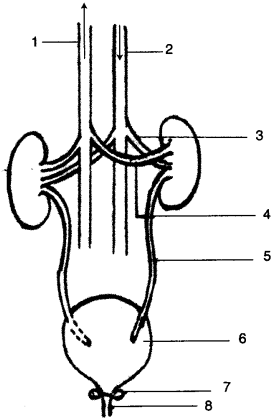 (i) Name the parts labelled 1, 2, 3 and 4.
(i) Name the parts labelled 1, 2, 3 and 4.
(ii) Give the main function of the parts labelled 5, 6, 7 and 8.
(iii) Name the endocrine gland which could be added in the diagram and state its location/position. [5]
(b) Briefly explain the following :
(i) Osmosis (ii) Allele (iii) Pulse (iv) Reflex action (v) Synapse [5]
Answer:
(a) (i) 1—Posterior Vena Cava
2—Aorta
3—Renal Artery
4—Renal Vein
(ii) Part 5 : Ureter – Carry urine from kidneys to urinary bladder.
Part 6 : Urinary bladder – Contain the urine till it is released out.
Part 7: Sphincter muscles – Guards the urethra
Part 8: Urethra – Passage through which urine is given out of the body.
(iii) Adrenal gland. It is located above each kidney in the form of a cap.
(b) (i) Osmosis : The process of movement of solvent molecules from a region of low concentration to a region of higher concentration through a semipermeable membrane.
(ii) Allele – It is one of the alternative form of the same gene responsible for determining contrasting characteristics.
(iii) Pulse – It is a wave of pressure of blood passing through the arteries as it is pumped out of the heart.
(iv) Reflex Action : It is a spontaneous, automatic, involuntary response to a stimulus.
(v) Synapse : It is the point of contact between the axon endings of one neuron with the dendrites of the other neuron through where the impulse is transmitted from one neuron to the other.
Question 5:
(a) Study the diagram given below and then answer the questions that follow :
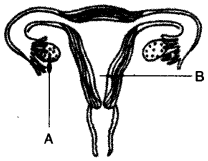 (i) Name the part labelled A. Name any two hormones produced by the part labelled A.
(i) Name the part labelled A. Name any two hormones produced by the part labelled A.
(ii) What happens to the part labelled B :
(1) If fertilisation takes place ? (2) If fertilisation does not take place ?
(iii) Where does fertilisation occur ?
(iv) Draw a neat diagram of the human sperm as seen under high magnifi-cation and label the following parts.
(1) Acrosome (2) Mitochondria [5]
(b) A homozygous plant having round (R) and yellow (Y) seed is crossed with homozygous plant having wrinkled (r) and green (y) seeds :
(i) Give the scientific name of the plant on which Mendel conducted his hybridization experiments.
(ii) Give the genotype of the F1 generation.
(iii) Give the dihybrid phenotypic ratio and the phenotype of the offspring of the F2 generation when two plants of the F1 generation are crossed.
(iv) Name and state the law which explains the dihybrid ratio.
(v) Give the possible combinations of gametes that can be obtained from F1 hybrid. [5]
Answer:
(a) (i) A – Ovary: Two hormones are :
(1) Oesterogen (2) Progesteron
(ii) (1) If fertilisation takes place, part B i.e. uterus gets prepared to receieve the embryo. The endometrial lining thickens and gets highly vascularised.
(2) If fertilisation does not take place part B, then the endometrial lining of uterus erodes causing bleeding i.e., menstruation.
(iii) Fertilisation occurs in the fallopian tube/oviduct.
(iv)
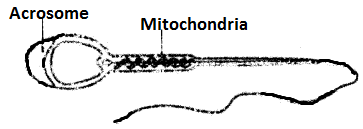
(b) (i) Pisum sativum
(ii) Genotype of the F1 generation Rr Yy
(iii) Ratio of F2 generation 9:3:3:1 Phenotypes of F2 generation are:
1. Round and yellow 2. Round and green
3. Wrinkled and yellow 4. Wrinkled and green
(iv) Law of Independent Assortment.
(v) F1 genotype: Rr Yy
So possible gamete combinations are
1. RY = Round yellow
2. rY = Wrinkled yellow
3. Ry = Round green
4. ry = Wrinkled green
Question 6:
(a) The diagram below is an experiment conducted to study a factor necessary for Photosynthesis Observe the diagrams and then answer the following questions:
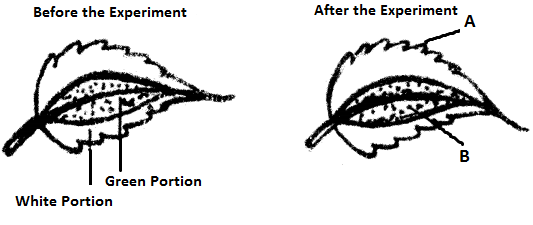 (i) What is the aim of the experiment ?
(i) What is the aim of the experiment ?
(ii) Name the test performed on the leaf and the solution used for the test.
(iii) What type of leaf was used for the experiment ? Give an example.
(iv) What is the exported result of the above test on the parts labelled A and B ?
(v) Give a balanced chemical equation to represent the process of Photosynthesis.
 [5]
[5]
(b) The diagram given below show the cross section of two kinds of blood vessels :
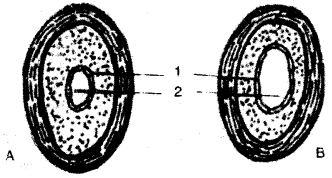 (i) Identify the blood vessels A and B. In each case give a reason to support your answer.
(i) Identify the blood vessels A and B. In each case give a reason to support your answer.
(ii) Name the parts numbered 1 and 2.
(iii) When are the sound “LUBB” and “DUP” produced during a heartbeat ? Name the blood vessel that :
(iv) Name the blood vessel that:
(1) begins and ends in capillaries
(2) supplies blood tc the walls of the heart [5]
Answer:
(a) (i) To show that chlorophyll is necessary ku photosynthesis.
(ii) Starch test.
Solution used in Iodine solution.
(iii) Variegated leaf/Coleus leaf (leaf having non green and green regions).
(iv) After performing starch test,
Part A turns blue black v/ith Iodine solution.
Part B turns brown with Iodine solution Sunlight
(b) (i) A – Artery, B – Vem
A has narrow lumen and thick muscular wall
B has wide lumen and thin muscular wall.
(ii) 1 – Endothelium
2 – Lumen
(iii) “LUBB”: Sound is produced when the two aurieuioventricular valves shut.
“DUP”: Sound is produced when the two semilunar valves shut 1 Begins and ends in capillaries: “Hepatic porta Vein”.
2. Supplies blood to the walls of the Heart: “Corunary artery”.
Question 7:
(a) Answer the following :
(i) Draw a well labelled diagram of a ‘Neuron’ and name the following parts
(1) Node of Randier
(2) Nissil granules
(3) Cyton
(ii) Name the part of the human brain which is concerned with the following :
(1) Heat of memory (2) Coordinates muscular activity
(iii) Mention any three major activities or the WHO. [5]
(b) (i) Draw a well labelled diagram to show the metopnase stage of Muosis in an animal cell ha ving four chromosomes.
(ii) Mention any two reasons for the population dguosicn In INDIA.
(iii) Give biological reasons for the following:
(1) Pituitary gland is also known as the master gland.
(2) Gametes have a haploid number of chromosome. [5]
Answer:
(a) (i)
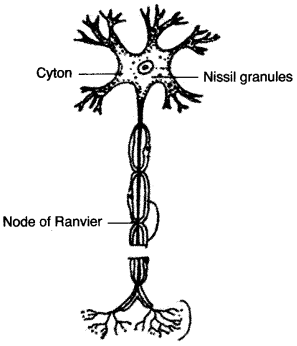
(ii) 1. Seat of Memory: Cerebrum.
2. Co-ordinates muscular activity: Cerebellum.
(iii) Activities of WHO:
1. Set pharmaceutical standards.
2. Suggests Quarantine measures.
3. Finances research on various diseases.
4. Suggests vaccinations against various diseases.
(b) (i)
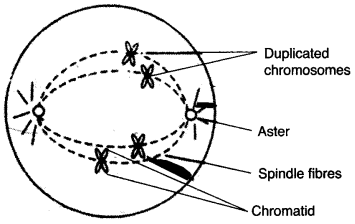
(ii) 1. Desire for a male child.
2. Lack of awareness about birth control measures.
(iii) 1. Pituitary gland secretes homones that regulates all other endocrine glands so it is called the master gland.
2. Gametes are produced by Meiosis in which the number of chromosomes gets reduced to half. So they are haploid.
Also so that during fertilisation the zygote has diploid number of chromosomes.
